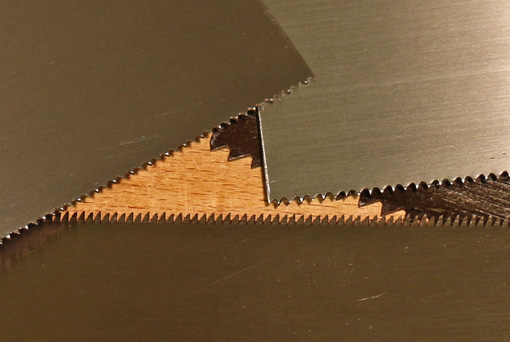
In saw descriptions and discussions, there is often the implicit assumption that a thinner saw cuts proportionately faster than a thicker saw. At the risk of setting this up as a straw man case, the assumption goes that, as an example, with all else being theoretically equal, a .012″ plate will cut twice as fast as a .024″ plate. Further, it follows that a thin-kerf saw has, within limits, this distinct advantage, assuming that its other sawing parameters can be controlled to maintain good function.
This would be analogous to a 24″ wide swath of snow being twice as hard to push as a 12″ swath, all else being equal. However, I don’t think saws work like that!
Let’s think about what a saw tooth does. A rip tooth cuts and plows the wood at the bottom of the kerf. In this, kerf width is probably roughly proportional to the effort, and thus inversely proportional to speed. At the sides of the kerf, the tooth shears the wood, and there the task is approximately the same regardless of kerf width.
The crosscut tooth severs the wood fibers at the sides of the kerf where, again, the task is approximately irrespective of kerf width. At the bottom of the kerf, where it is a lesser task of shuffling away the broken wood, the work is probably about proportionate to the kerf width.
Thus, in both cases, especially crosscutting, this simple idealized analysis suggests that, all else being equal, twice the kerf width does not mean half the sawing speed. It is not like pushing snow.
In reality, all else is never equal, of course, and the dynamics are surely more complicated than described here. Nonetheless, this way of looking at it at least gives some basis to explain my real world observations using many saws that, within limits, thinner kerf saws do not seem to give a proportionate advantage in cutting speed over thicker kerf saws.
Again, my argument is against this as an assumption that may be made by some when comparing saws. This is applicable in comparing among Western saws, and generally comparing Western with Japanese saws.
Further, as plate thickness is reduced too much, especially in Western saws, disadvantages ensue. Among these, depending on other design parameters, is a tendency to distort in the heat and action of sawing. Also, energy intended for cutting seems to get wasted in vibrating the skinny saw plate, somewhat akin to action of a thin or poorly supported plane blade.
In summary, skinnier is not as attractive as it might seem. It is important to look at the whole picture when choosing saws.
Next: Ah, but is the thinner kerf saw inherently more accurate, all else being equal? Does that make skinny better?


Good post, Rob. Those are the same conclusions I reached about the cutting action of saws, and is one of the reasons I am not a huge fan of the thin movement. Thin is nice up to a certain point, but some of these anorexic saws get a little hard to control.
Isaac
Thanks for reading and commenting, Isaac.
Readers, be sure to check out http://www.blackburntools.com for the saws Isaac produces and the wealth of saw knowledge he shares.
Rob